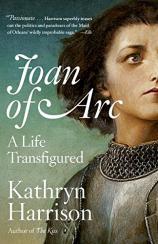Joan of Arc: A Life Transfigured
Review
Joan of Arc: A Life Transfigured
A slender, healthy teenager, Joan of Arc had the ability to “banish the lust of any who might admire her,” even the rough soldiers with whom she cast her lot. An illiterate peasant girl destined to lead an army, impelled by the voices of an angel and two saints, she was dead by age 19, condemned as a witch and burned to ashes.
In the hands of Kathryn Harrison, a consummate novelist (THE SEAL WIFE), memoirist (THE KISS) and biographer (SAINT THERESE OF LISIEUX), the girl who battled armies like a hardened soldier and argued with inquisitors like an experienced lawyer springs to life for a new generation. Whether one venerates Joan (she was canonized nearly 500 years after her ignominious execution) or simply admires her physical courage and artful mental sparring with her captors, one will pore over Harrison’s book for its highly readable attention to detail.
"Whether one venerates Joan (she was canonized nearly 500 years after her ignominious execution) or simply admires her physical courage and artful mental sparring with her captors, one will pore over Harrison’s book for its highly readable attention to detail."
While making her own inferences, Harrison presents Joan through the eyes of a myriad of other biographers and artists: the Maid was everything from a pretty shepherdess (Cecil B. DeMille) to an unlikely long-haired Valkyrie in skirted armor (Ingres), to a genderless tomboy, straight-lipped and close-cropped (Otto Preminger). Voltaire satirized her with bawdy inference, reflecting more negatively on him than on his subject; DeMille depicted her crucified, “nailing her not to a cross but to a great fleur-de-lis.”
Harrison de-romanticizes the Maid’s tale, especially the horrors of warfare. Contrary to legend (and there is much of legend about this life), not every soldier was a genteel nobleman, and battles into which Joan led her men were “a slippery muck of dirt and blood and excrement.” That a girl in her teens could wear 40 to 50 pounds of metal, bear privations including grave wounding, and face combat like a man is in itself amazing; Harrison asserts that Joan’s presence, on horseback and bearing a standard, excited her troops “to giddy bloodlust.”
However, it was the tragedies, not the triumphs, that made the girl a saint. Even as she had carried out the tasks her voices had set her to, she was captured and, almost certainly fraudulently, tried. During her imprisonment, hobbled in irons, she produced answers that, Jesus-like, deflected the trickery of her cross-examiners. When asked if St. Michael appeared to her naked, she shot back, “Do you think God has not the wherewithal to clothe him?” It is not difficult to see in Joan’s story, as presented by Harrison, the fury and frustration of powerful men at the indomitable spirit of a young female who “contrary to natural decency” refused to submit to their will. The Maid’s executioner, instructed to burn her body to ashes and throw them in the Seine so no one could claim any of her relics, later declared, “I never wept as much for anything that befell me.”
Harrison says that recreating the life of Joan of Arc was “the headiest and happiest writing of my life,” a powerful statement from an already lauded artist, who doubtless now has greater praise awaiting.
Reviewed by Barbara Bamberger Scott on November 21, 2014
Joan of Arc: A Life Transfigured
- Publication Date: October 13, 2015
- Genres: Biography, History, Nonfiction
- Paperback: 416 pages
- Publisher: Anchor
- ISBN-10: 0767932498
- ISBN-13: 9780767932493




